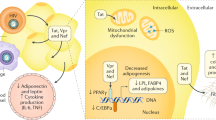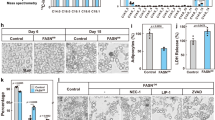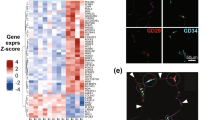Abstract
Objective:
Lipodystrophy is the major complication of antiretroviral therapy in HIV-infected patients. Its pathophysiology is not well understood, but has been linked to antiadipogenic effects of antiretroviral drugs. Lipin represents a newly characterized protein that is critical for adipocyte differentiation, and lipin deficiency leads to lipodystrophy in the mouse. The objective of this study was to determine whether altered lipin gene expression is associated with HIV lipodystrophy in humans.
Design:
We measured lipin mRNA levels in subcutaneous abdominal and femoral-gluteal adipose tissue biopsies from HIV-infected patients with or without lipodystrophy, and in healthy controls. Real-time reverse transcription-PCR was performed to quantitate total lipin expression levels, and expression of two lipin isoforms (lipin-α and -β) that are generated by alternative mRNA splicing.
Results:
As predicted from studies with mice, lipin mRNA levels were correlated with limb fat mass in HIV patients, with lower lipin levels in patients with lipodystrophy than those without lipodystrophy. Unexpectedly, however, this was explained by an increase in lipin-β expression in HIV patients without lipodystrophy compared to patients with lipodystrophy and control subjects. In addition, lipin expression levels were inversely correlated with adipose tissue expression of inflammatory cytokines interleukin (IL)-6, IL-8 and IL-18, which typically increase in HIV-associated lipoatrophy.
Conclusions:
Elevated lipin expression levels are associated both with the maintenance of greater fat mass and lower cytokine expression in HIV-infected patients. Based on the demonstrated role for lipin in promoting lipogenic gene expression, these observations raise the possibility that variations in lipin levels may contribute to variations in adipose tissue mass and function that distinguish HIV patients with and without lipodystrophy.
This is a preview of subscription content, access via your institution
Access options
Subscribe to this journal
Receive 12 print issues and online access
$259.00 per year
only $21.58 per issue
Buy this article
- Purchase on Springer Link
- Instant access to full article PDF
Prices may be subject to local taxes which are calculated during checkout



Similar content being viewed by others
References
Carr A, Emery S, Law M, Puls R, Lundgren JD, Powderly WG . An objective case definition of lipodystrophy in HIV-infected adults: a case–control study. Lancet 2003; 361: 726–735.
Hansen AE, Lindegaard B, Obel N, Andersen O, Nielsen H, Gerstoft J . Pronounced lipoatrophy in HIV-infected men receiving HAART for more than six years compared with background population. HIV Med 2005; 7: 38–45.
Bacchetti P, Gripshover B, Grunfeld C, Heymsfield S, McCreath H, Osmond D et al. Fat distribution in men with HIV infection. J Acquir Immune Defic Syndr 2005; 40: 121–131.
Garg A . Acquired and inherited lipodystrophies. N Engl J Med 2004; 350: 1220–1234.
Carr A, Samaras K, Chisholm DJ, Cooper DA . Pathogenesis of HIV-1-protease inhibitor-associated peripheral lipodystrophy, hyperlipidaemia, and insulin resistance. Lancet 1998; 351: 1881–1883.
Lawrence R . Lipodystrophy and hepatomegaly with diabetes, lipemia and other metabolic disturbances: a case throwing new light on the action of insulin. Lancet 1946; 1: 724–731.
Rossini AA . Lipoatrophic diabetes. In: Marble A, Krall LP, Bradley RF, Christlieb AR, Soeldner JS (eds). Joslin's Diabetes Mellitus. Lea & Febiger: Philadelphia, 1985. pp 834–842.
Zhang B, MacNaul K, Szalkowski D, Li Z, Berger J, Moller DE . Inhibition of adipocyte differentiation by HIV protease inhibitors. J Clin Endocrinol Metab 1999; 84: 4274–4277.
Dowell P, Flexner C, Kwiterovich PO, Lane MD . Suppression of preadipocyte differentiation and promotion of adipocyte death by HIV protease inhibitors. J Biol Chem 2000; 275: 41325–41332.
Wentworth JM, Burris TP, Chatterjee VK . HIV protease inhibitors block human preadipocyte differentiation, but not via the PPARgamma/RXR heterodimer. J Endocrinol 2000; 16: R7–R10.
Lenhard JM, Furfine ES, Jain RG, Ittoop O, Orband-Miller LA, Blanchard SG et al. HIV protease inhibitors block adipogenesis and increase lipolysis in vitro. Antiviral Res 2000; 4: 121–129.
Caron M, Auclair M, Vigouroux C, Glorian M, Forest C, Capeau J . The HIV protease inhibitor indinavir impairs sterol regulatory element-binding protein-1 intranuclear localization, inhibits preadipocyte differentiation, and induces insulin resistance. Diabetes 2001; 50: 1378–1388.
Caron M, Auclair M, Sterlingot H, Kornprobst M, Capeau J . Some HIV protease inhibitors alter lamin A/C maturation and stability, SREBP-1 nuclear localization and adipocyte differentiation. Aids 2003; 17: 2437–2444.
Caron M, Auclair M, Lagathu C, Lombes A, Walker UA, Kornprobst M et al. The HIV-1 nucleoside reverse transcriptase inhibitors stavudine and zidovudine alter adipocyte functions in vitro. Aids 2004; 18: 2127–2136.
Reue K, Xu P, Wang XP, Slavin BG . Adipose tissue deficiency, glucose intolerance, and increased atherosclerosis result from mutation in the mouse fatty liver dystrophy (fld) gene. J Lipid Res 2000; 4: 1067–1076.
Reue K, Peterfy M . Mouse models of lipodystrophy. Curr Atheroscler Rep 2000; 2: 390–396.
Peterfy M, Phan J, Xu P, Reue K . Lipodystrophy in the fld mouse results from mutation of a new gene encoding a nuclear protein, lipin. Nat Genet 2001; 27: 121–124.
Phan J, Reue K . Lipin, a lipodystrophy and obesity gene. Cell Metab 2005; 1: 73–83.
Phan J, Peterfy M, Reue K . Lipin expression preceding peroxisome proliferator-activated receptor-gamma is critical for adipogenesis in vivo and in vitro. J Biol Chem 2004; 279: 29558–29564.
Han GS, Wu WI, Carman GM . The Saccharomyces cerevisiae Lipin homolog is a Mg2+-dependent phosphatidate phosphatase enzyme. J Biol Chem 2006; 281: 9210–9218.
Huffman TA, Mothe-Satney I, Lawrence Jr JC . Insulin-stimulated phosphorylation of lipin mediated by the mammalian target of rapamycin. Proc Natl Acad Sci USA 2002; 99: 1047–1052.
Peterfy M, Phan J, Reue K . Alternatively spliced lipin isoforms exhibit distinct expression pattern, subcellular localization, and role in adipogenesis. J Biol Chem 2005; 280: 32883–32889.
Carr A, Samaras K, Thorisdottir A, Kaufmann GR, Chisholm DJ, Cooper DA . Diagnosis, prediction, and natural course of HIV-1 protease-inhibitor-associated lipodystrophy, hyperlipidaemia, and diabetes mellitus: a cohort study. Lancet 1999; 353: 2093–2099.
Hadigan C, Miller K, Corcoran C, Anderson E, Basgoz N, Grinspoon S . Fasting hyperinsulinemia and changes in regional body composition in human immunodeficiency virus-infected women. J Clin Endocrinol Metab 1999; 84: 1932–1937.
Keller P, Keller C, Carey AL, Jauffred S, Fischer CP, Steensberg A et al. Interleukin-6 production by contracting human skeletal muscle: autocrine regulation by IL-6. Biochem Biophys Res Commun 2003; 310: 550–554.
Bastard JP, Caron M, Vidal H, Jan V, Auclair M, Vigouroux C et al. Association between altered expression of adipogenic factor SREBP1 in lipoatrophic adipose tissue from HIV-1-infected patients and abnormal adipocyte differentiation and insulin resistance. Lancet 2002; 359: 1026–1031.
Mynarcik DC, McNurlan MA, Steigbigel RT, Fuhrer J, Gelato MC . Association of severe insulin resistance with both loss of limb fat and elevated serum tumor necrosis factor receptor levels in HIV lipodystrophy. J Acquir Immune Defic Syndr 2000; 25: 312–321.
Vigouroux C, Maachi M, Nguyen TH, Coussieu C, Gharakhanian S, Funahashi T et al. Serum adipocytokines are related to lipodystrophy and metabolic disorders in HIV-infected men under antiretroviral therapy. Aids 2003; 17: 1503–1511.
Kannisto K, Sutinen J, Korsheninnikova E, Fisher RM, Ehrenborg E, Gertow K et al. Expression of adipogenic transcription factors, peroxisome proliferator-activated receptor gamma co-activator 1, IL-6 and CD45 in subcutaneous adipose tissue in lipodystrophy associated with highly active antiretroviral therapy. Aids 2003; 17: 1753–1762.
Park YW, Heymsfield SB, Gallagher D . Are dual-energy X-ray absorptiometry regional estimates associated with visceral adipose tissue mass? Int J Obes Relat Metab Disord 2002; 26: 978–983.
Kamel EG, McNeill G, Han TS, Smith FW, Avenell A, Davidson L et al. Measurement of abdominal fat by magnetic resonance imaging, dual-energy X-ray absorptiometry and anthropometry in non-obese men and women. Int J Obes Relat Metab Disord 1999; 23: 686–692.
Snijder MB, Visser M, Dekker JM, Seidell JC, Fuerst T, Tylavsky F et al. The prediction of visceral fat by dual-energy X-ray absorptiometry in the elderly: a comparison with computed tomography and anthropometry. Int J Obes Relat Metab Disord 2002; 26: 984–993.
Cotter BR, Torriani FJ . Cardiovascular effects of antiretroviral therapy and noninvasive assessments of cardiovascular disease in HIV infection. Cardiovasc Toxicol 2004; 4: 281–286.
Johnson JA, Albu JB, Engelson ES, Fried SK, Inada Y, Ionescu G et al. Increased systemic and adipose tissue cytokines in patients with HIV-associated lipodystrophy. Am J Physiol Endocrinol Metab 2004; 286: E261–E271.
Lihn AS, Richelsen B, Pedersen SB, Huagaard SB, Rathje GS, Madsbad S et al. Increased expression of TNF-alpha, IL-6, and IL-8 in HALS: implications for reduced adiponectin expression and plasma levels. Am J Physiol Endocrinol Metab 2003; 285: E1072–E1080.
Reitman ML . Metabolic lessons from genetically lean mice. Annu Rev Nutr 2002; 22: 459–482.
Acknowledgements
We thank the patients for their participation in this study. We also acknowledge Ruth Rousing, Hanne Willumsen, Lene Pors and Bente Baadegaard for excellent technical help. The study was supported by the Danish Medical Research Council (22-01-0019), the Danish National Research Foundation, the Danish AIDS Foundation and the United States Public Health Service (P01 HL28481).
Author information
Authors and Affiliations
Corresponding author
Rights and permissions
About this article
Cite this article
Lindegaard, B., Larsen, L., Hansen, AB. et al. Adipose tissue lipin expression levels distinguish HIV patients with and without lipodystrophy. Int J Obes 31, 449–456 (2007). https://doi.org/10.1038/sj.ijo.0803434
Received:
Revised:
Accepted:
Published:
Issue Date:
DOI: https://doi.org/10.1038/sj.ijo.0803434
Keywords
This article is cited by
-
UVB-dependent inhibition of lipin-1 protects against proinflammatory responses in human keratinocytes
Experimental & Molecular Medicine (2020)
-
Exendin-4 improves ER stress-induced lipid accumulation and regulates lipin-1 signaling in HepG2 cells
Cell Stress and Chaperones (2018)
-
The mRNA of lipin1 and its isoforms are differently expressed in the longissimus dorsi muscle of obese and lean pigs
Molecular Biology Reports (2011)



